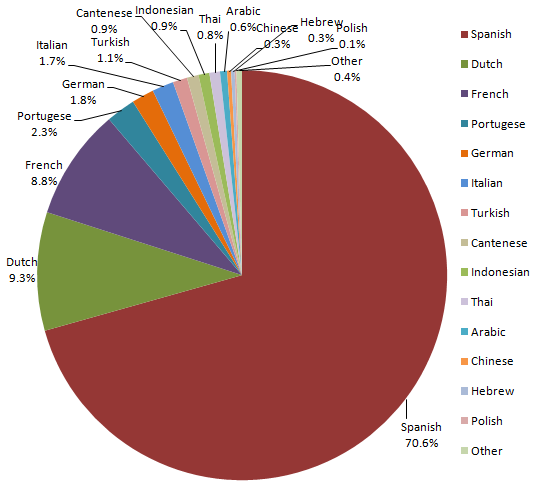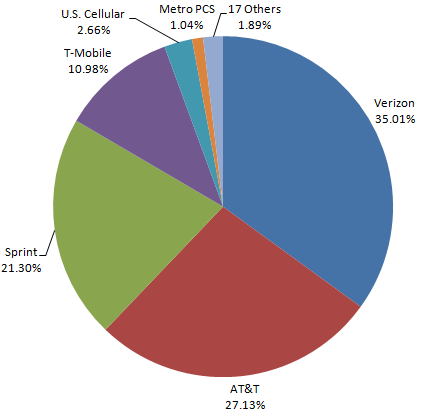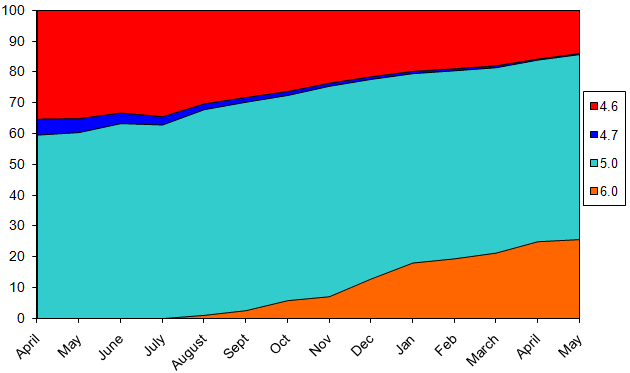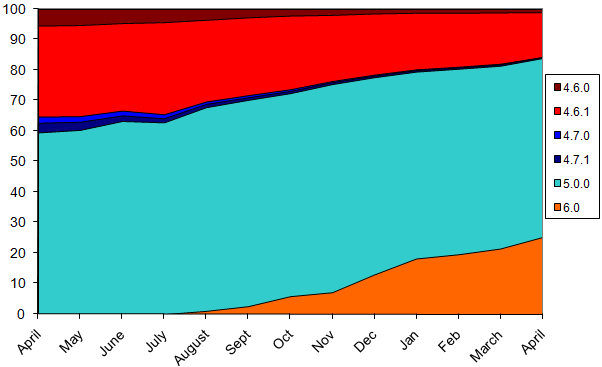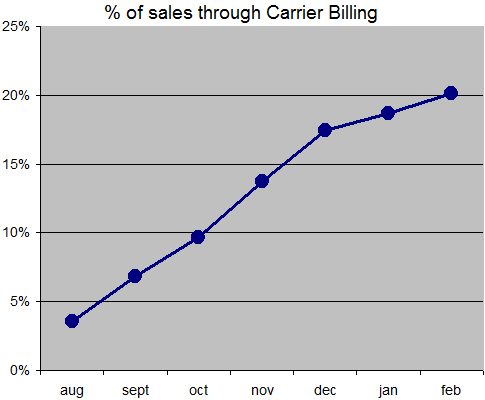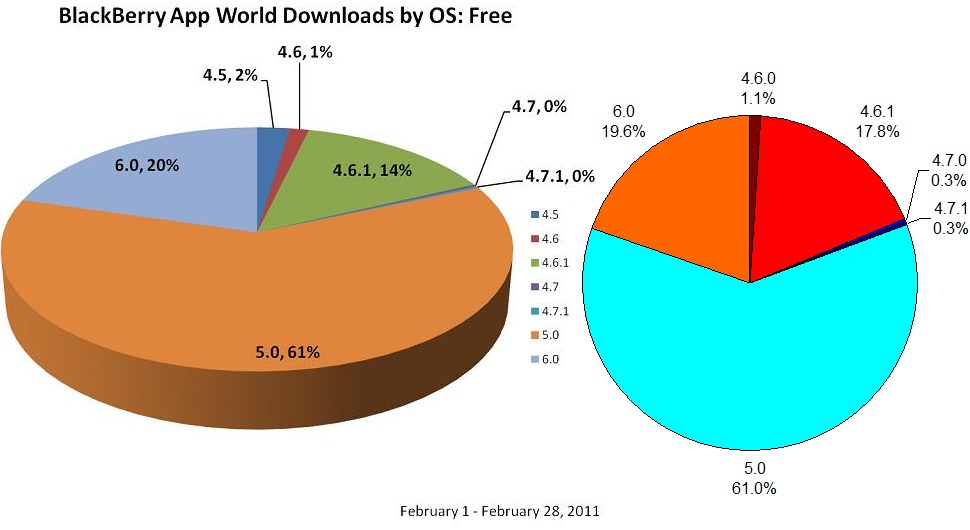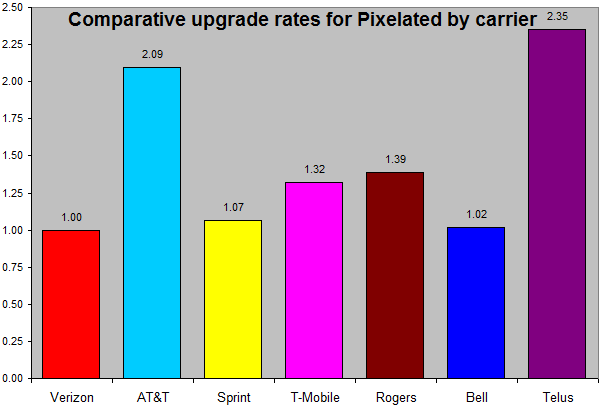 The chart to the right shows the percentage of Pixelated users with each language set as the default. It is safe to assume that the fact that this data comes from an English-only application will result in some bias in these values. The chart below shows the percent of downloads for every language besides English.
The chart to the right shows the percentage of Pixelated users with each language set as the default. It is safe to assume that the fact that this data comes from an English-only application will result in some bias in these values. The chart below shows the percent of downloads for every language besides English.
Multi-lingual BlackBerry users
Monthly BlackBerry OS usage
Version 6.0 of the BlackBerry operating system saw a 3.36% increase in overall market share from May to June. Use of OS 5.0+ is now up to 86.8% of active BlackBerry users.
Adoption of OS 6.0 continues to be slower then adoption of OS 5.0 was due to the lack of an upgrade path for many popular phones such as the 85xx and 95xx series. As such adoption of OS 7.0 is more likely to follow the adoption curve of OS 6.0 because it is more likely to reflect adoption through new device sales rather then through upgrades to exciting devices.
As usual this data is taken from downloads of the popular BlackBerry strategy game Pixelated. Data starts from the release of version 2.0 in April of 2010, and goes through the end of last month.
BlackBerry carriers in the US
US based wireless carriers by percentage of US BlackBerry market share as of June 2011. Data based on downloads of the popular free strategy game Pixelated.
Updated PlayBook sales estimate
I took a crack at estimating PlayBook sales about a month ago, but with RIM set to release sales number tomorrow, I figured that I would take one more guess to see how accurate any of my estimating actually is.
The Wall Street Journal reported that analysts expect that RIM has shipped about 436,000 PlayBooks. CrackBerry is estimating sales under 200,000 units. I think the Wall Street Journal is much closer.
As of yesterday I am estimating that RIM has sold between 258,000 and 800,000 PlayBooks. My best guess is that they have sold 429,000 tablets, which is very close the the analyst guess.
This estimate is based on a lot of assumptions, and guess work but is based on the number of downloads of the free game Pixelated. However, as Pixelated has remained one of the top 10 most popular applications on the PlayBook, I feel that I have better numbers then most people to base this guess on.
Breakdown of BlackBerry OS use
Use of BlackBerry OS 6.0 is up slightly from last month to 25.9% of all users. The growth of users at OS 5.0 or higher saw slightly larger gains, and is now up to 85.8% of all BlackBerry users.
There were also some users of OS 7 in the logs, although those were left out of this chart. Besides the 9900/9930 there are also indications of devices in the Torch and Curve families running OS 7 (which is in line with leaks that have come out).
As usual this data is taken from downloads of the popular BlackBerry strategy game Pixelated. Data starts from the release of version 2.0 in April of 2010, and goes through the end of last month.
Carrier Billing continues to grow
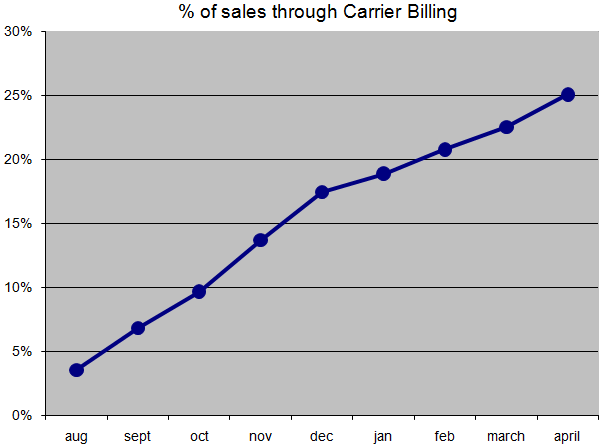 Since last looked at, Carrier Billing has continued to grow. As of April 2011, it accounted for 25.1% of all sales in AppWorld. For more details please see the full article at berryreview.com
Since last looked at, Carrier Billing has continued to grow. As of April 2011, it accounted for 25.1% of all sales in AppWorld. For more details please see the full article at berryreview.com
This data is generated from the dollar amount of purchases of all Ebscer applications over the given month.
OS 6 finally seeing some uptake by older devices
Rates of older OS 5.0 devices upgrading to OS 6.0 has finally increased beyond being just a few percent. So far the CDMA devices are leading the way with both the 9330, and 9650 seeing more then half of their users on the newer operating system.
| Device | % at OS 6 |
| 91xx | 5.4% |
| 9300 | 11.3% |
| 9330 | 69.7% |
| 9650 | 61.2% |
| 9700 | 15.9% |
These numbers are much improved from January, but are still lower then they should be. Furthermore the overall situation is actually a bit worse because of the above devices the 9300, and the 9700 are the most popular.
This data comes from April downloads of Pixelated, the most popular strategy game in BlackBerry AppWorld.
PlayBook Sales estimate
According to BGR (found via BlackBerryCool), RBC is estimating that RIM has sold 250,000+ BlackBerry PlayBooks in what has now been about a month of availability. This is in line with my estimate last week at the same number.
I don’t know exactly as of what date the RBC estimate is based off of, but as of yesterday I am now estimating that RIM has sold between 238,000 and 570,000 PlayBooks. Based off of the data I have, my best guess is that have sold 272,500 tablets in the first month.
This estimate is based on a lot of assumptions, and guess work as I do not have the actual number of tablets sold. However, as Pixelated has been one of the most popular applications on the PlayBook, I do have better numbers then most people, so I figured that I would share.
BlackBerry OS usage over the past year
The number of BlackBerry phones running OS 6.0 has increased to 25.2% of the market last month. While 84.0% of BlackBerrys now run OS 5.0 or higher.
Eight months after the release of OS 5.0 it had already captured over twice the market, while OS 6.0 is only doing half as well at the eight month mark. Overall adoption of the newer OS is mostly being held back by the limited number of upgrades from devices that originally were released with 5.0 operating systems. Given the lack of an upgrade path, it would be expected to see a similarly slow uptake of OS 7.0 when it is released this summer. (Although 7.0 will be helped some by being available on all the major US carriers at launch).
As usual this data is taken from downloads of the popular BlackBerry strategy game Pixelated. Data starts from the release of version 2.0 in April of 2010, and goes through the end of last month.
Carrier Billing results in double sales
As an update to the importance of carrier billing, looking at the first three months of 2011 confirms that carrier billing results in twice as many sales. The complete chart and data are posted at berryreview.com with the larger sample size showing the relationship to be even more clear.
Use of Carrier Billing continues to rise
Since last looked at the usage of carrier billing has continued to rise in the first two months of 2011. Carrier billing now is responsible for 20.1% of all sales on BlackBerry AppWorld. The use of in-application payments will most likely continue to rise as it is being offered on more carriers. These carriers see their users twice as likely to upgrade to paid versions of applications as they otherwise would be.
RIM’s war on pre-OS 5.0 devices
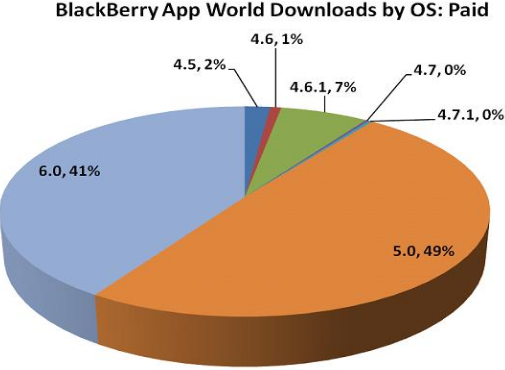 At the recent BlackBerry Developer Day RIM repeatedly pointed out that (as the chart shows) 90% of paid applications were downloaded by users running OS 5.0 or higher. Again and again this point was brought up along with the recommendation that developers not bother coding for the older operating systems.
At the recent BlackBerry Developer Day RIM repeatedly pointed out that (as the chart shows) 90% of paid applications were downloaded by users running OS 5.0 or higher. Again and again this point was brought up along with the recommendation that developers not bother coding for the older operating systems.
The question of course is why. The answer being that it allows RIM to get away from the perception that there is a lot of fragmentation in developing for BlackBerry, and that it allows BlackBerry applications to look nicer. Given that BlackBerry has been around a lot longer then iOS or Android many developers view working for BlackBerry as a larger task because of the need to support these legacy devices. RIM in turn is simply telling developers not to bother with the older devices, and figuring that well over a year after release, anyone not going to update to OS 5.0 or higher probably isn’t going to download any applications anyhow. Additionally this can help make BlackBerry applications look nicer as developers will be less afraid of using the newer APIs. If instead a developer decided that they needed to support a lowest common denominator of OS 4.5 they wouldn’t even have the decor APIs available to them, and would look awful.
RIM themselves has been holding true to this minimum of OS 5.0 by requiring this for things like the newest version of BBM, and the upcoming BlackBerry Bridge. Like all other developers RIM too can get more done if they only have to support OS 5.0 and newer devices.
The launch of Twinkle last summer was the first Ebscer application to require a minimum OS of 5.0 and since then Liar’s Dice and Xploiding Boxes have had the same requirement. Meanwhile others like the Call-A-Human application support OS 4.6.0 and higher but work much better when integrated with Universal Search on OS 6.0 devices.
The final message is that if you haven’t updated to OS 5.0 yet you are already missing out. If you haven’t updated to OS 6.0 yet you soon will be.
RIM’s OS usage reports reflects our own
RIM has updated their OS usage statistics using February data. Unlike last time they broke out the number of users on OS 6. These official numbers look very close to what I reported for February. For OS 6.0 RIM reports 20% while I saw 19.6%. For OS 5.0+ RIM reports 81%, while I see 80.6%. Additionally we both see almost no users on OS 4.7.0 and 4.7.1.
The importance of Carrier Billing
Last week when looking at the increasing popularity of carrier billing I noticed that the percent of purchases made through carrier billing was larger then the percent of customers who had access to carrier billing. A quick look at the number for December then showed that users of AT&T were more then twice as likely to upgrade from Pixelated to Pixelated Plus then users from Verizon, Sprint, and T-mobile.
I attributed this difference to having the option of carrier billing, but AT&T is also the only one of these carriers to offer RIM’s flagship BlackBerry Torch. In order to double check these assumptions I looked at the three largest Canadian carriers who all offer the Torch, and only one (Telus) offers carrier billing through AppWorld.
In the interest of not actually reveling upgrade rates, the below chart instead shows rates normalized to the rate at Verizon, such that Verizon is always 1.0 and carriers with a higher upgrade rate show values higher then one. Additionally this is not a true measure of upgrade rates but a value of paid downloads over free downloads which is good enough to normalize the amount of purchases over the relative size of the carriers. This data is from the month of January.
As the chart shows the two wireless providers that offer carrier billing through AppWorld have roughly double the percentage of customers who are willing to spend money on an upgrade. As such one of the best things that RIM can do to help developers is to get more providers on board with carrier billing.
Carrier Billing increasing in popularity
Carrier billing has increased from account for just 3.5% of sales in August, to 17.5% of sales in December. This method of buying applications so far is proving to be very popular, and will only continue to increase in popularity as the option becomes available through more wireless carriers.
During this time frame carrier billing was available only to customers of AT&T which has made these BlackBerry users more likely to purchase applications. In December 2010 the upgrade rate from the free version of Pixelated to Pixelated Plus among customers on AT&T’s network were over twice the rate of customers of Verizon, and T-Mobile (USA), and over three times the rate of customers on Sprint network. As such RIM adding more partners for carrier billing is great news for developers.
